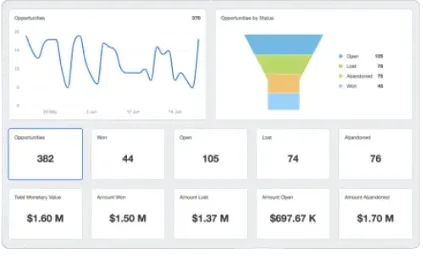Read Our Latest Blogs
Lorem ipsum dolor sit amet, consectetur adipiscing elit. Cras in fringilla turpis, eu consequat ante.

Understanding the Revenue Journey: From Prospect to Customer
Unlock the Power of a Seamless Revenue Funnel
Every thriving business follows a structured path to convert potential buyers into loyal customers. But without a well-defined process, companies risk losing valuable opportunities. The key to success? Understanding the distinct stages a contact goes through before they become a paying customer.
In this guide, we break down the essential steps—from prospect to lead, lead to opportunity, and opportunity to customer—ensuring your team optimizes engagement and maximizes revenue growth.
Why This Process Matters
According to Forrester Research, companies that follow a structured revenue operations process see 10-15% higher revenue growth compared to those that don’t. A clear prospect-to-customer journey helps:
✅ Align sales and marketing for better efficiency.
✅ Increase conversion rates at every stage.
✅ Improve customer experience and retention.
The Revenue Journey: Step by Step
RevOps (Revenue Operations) professionals generally define prospects, leads, and customers in a structured buyer journey that aligns sales, marketing, and customer success. The order usually follows this sequence:
Prospect → 2. Lead → 3. Opportunity (optional stage) → 4. Customer → 5. Advocate
Each stage is defined based on engagement, qualification, and intent.
1. Prospect: Identifying Potential Customers
The first in the customer journey is when a person becomes a prospect. A prospect is a potential customer who fits your ideal customer profile (ICP) but has not yet engaged with your company.
Key Traits:
Matches your target industry, company size, and role.
Has shown no direct interest in your product or service yet.
May not be aware of the problem you solve.
How Are Prospects Identified?
Prospects are identified through a combination of data-driven targeting, market research, and strategic outreach. Here’s how businesses commonly identify prospective customers:
1. Defining the Ideal Customer Profile (ICP)
Identify key demographics (industry, company size, location).
Analyze demographics such as annual revenue, growth stage, and number of employees.
Determine pain points your product/service solves.
Understand buyer behavior and challenges in their market.
2. Market Research & Data Sources
Leverage B2B databases (e.g., LinkedIn Sales Navigator, ZoomInfo, Crunchbase).
Monitor industry trends and emerging market needs.
Analyze competitor customer lists (if publicly available).
3. Website Traffic & Digital Engagement
Use tools like Google Analytics and heatmaps to track visitor behaviors.
Identify repeat website visitors or those engaging with key pages (pricing, case studies).
4. Social Media & Online Communities
Monitor LinkedIn, industry forums, and professional groups.
Engage in conversations where potential customers discuss problems your business solves.
Track brand mentions and sentiment using social listening tools.
5. Outbound Prospecting & List Building
Cold outreach through email, phone, or LinkedIn messaging.
Event networking (conferences, trade shows, webinars).
Referral programs and strategic partnerships.
6. Inbound Marketing & Content Strategy
SEO-optimized blog posts and thought leadership attract relevant visitors.
Lead magnets (whitepapers, guides, reports) encourage downloads.
Email nurturing sequences to keep prospects engaged.
Example: Sarah, a VP of Operations at a mid-sized SaaS company, has never interacted with your brand. However, her company fits your target market, making her a qualified prospect.
Transition to Lead: A prospect becomes a lead when they take action—filling out a contact form, downloading a whitepaper, or attending a webinar.
2. Lead: Engaged and Curious
Definition: A lead is a prospect who has shown interest by interacting with your brand.
Types of Leads:
Marketing-Qualified Lead (MQL): Meets engagement criteria such as repeated website visits, content downloads, or webinar attendance.
Sales-Qualified Lead (SQL): Evaluated by sales and deemed ready for direct outreach.
Product-Qualified Lead (PQL): Has engaged with a free trial or freemium product and shows strong buying signals.
Example: After reading a blog post on workflow automation, Sarah downloads your "Ultimate Guide to Streamlining Operations." She is now a marketing-qualified lead (MQL).
Transition to Opportunity: A lead becomes an opportunity when they request a demo, inquire about pricing, or fit the BANT criteria (Budget, Authority, Need, Timeline).
3. Opportunity: The Sales Process Begins
Definition: A qualified lead who has entered the sales pipeline and is actively evaluating your solution.
Key Traits:
Engaged in direct conversations with sales.
Actively considering purchase options.
May have received a proposal or custom pricing.
Example: Sarah books a demo, meets with your sales rep, and discusses how your platform can integrate with her company's existing tools. She is now a sales opportunity.
Transition to Customer: An opportunity becomes a customer when they sign a contract, make a purchase, or complete onboarding.
4. Customer: The Journey Continues
Definition: A paying client who has completed the transaction and is now using your product or service.
Next Steps for Growth:
Retention & Expansion: Deliver value, offer upsells, and maintain strong customer relationships.
Advocacy: Turn satisfied customers into referral sources, brand ambassadors, or case study participants.
Example: Sarah signs a 12-month contract, successfully implements your solution, and later refers another department within her company. She transitions from a customer to an advocate.
Optimize Your Revenue Operations Today
Is your team maximizing every revenue opportunity? A disorganized approach leads to missed sales and inefficient workflows. Let us help you refine your prospect-to-customer strategy with proven methods that increase conversions and boost revenue.
📢 Get a Free Consultation today and start turning more leads into loyal customers.

© 2022 Company Name - All Rights Reserved, consectetur adipiscing elit. Maecenas commodo suscipit tortor, vel tristique sapien

